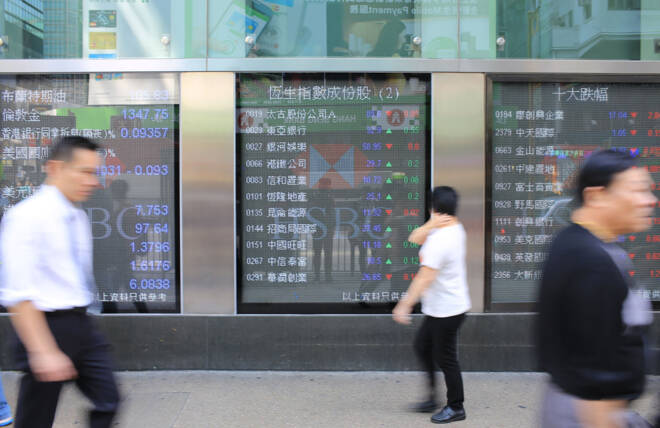Advertisement
Advertisement
Hang Seng Index and Mainland China Stocks Rally; Nikkei Drops on Yen Strength
By:
Key Points:
- Hang Seng gains on China stimulus hopes as Mainland markets rally; tech stocks show mixed performance.
- Tokyo inflation fuels BoJ rate hike bets; stronger yen pushes Nikkei lower as exporters feel the pressure.
- ASX 200 falls as banking stocks slump; RBA commentary dampens rate cut expectations, affecting sentiment.
US Markets: Futures Advance on Falling Treasury Yields
Are falling Treasury yields paving the way for a rally in riskier assets? Here’s what US futures reveal.
On Friday, November 29, US futures advanced, with the Dow Jones mini futures and Nasdaq 100 mini futures seeing gains of 126 points and 82.5 points, respectively. Falling 10-year US Treasury yields since Thursday have fueled demand for riskier assets.
Positive sentiment toward the US economy contributed to gains across the US futures on Thursday and early in the Friday session.
There was no trading on the Dow, Nasdaq Composite Index, or the S&P 500 on Thursday as the US equity markets were closed for the Thanksgiving holiday.
Tokyo Inflation Boosts Yen Demand, Impacting the Nikkei
On Friday, Tokyo’s core inflation rate increased from 1.8% in October to 2.2% in November, rising above the BoJ’s 2% target.
Could Tokyo’s inflation data push the BoJ closer to a December rate hike?
Inflation figures for Tokyo fueled speculation about a December Bank of Japan rate hike. Expectations for a December rate hike left the USD/JPY pair down by 0.88% to 150.164 in the morning session. Significantly, the USD/JPY dropped below 150 for the first time since October 21 before steadying.
China Stimulus Hopes Resurface
Is Beijing ready to roll out bold measures to boost consumer demand and counter US tariffs?
Speculation about further stimulus measures from Beijing intensified on Thursday as investors considered the upcoming Central Economic Work Conference. Economists expect Beijing to increase its focus on domestic consumer demand to counter the potential effects of US tariffs on China. The Central Economic Work Conference typically takes place in December.
Investors have clamored for measures to target domestic consumer consumption since Beijing’s latest round of stimulus measures.
Hang Seng Index and Mainland China Markets Advance on Stimulus Hopes
Stimulus buzz drives modest gains in Hong Kong markets—can the rally sustain?
In Asian markets, the Hang Seng Index edged 0.11% higher on Friday morning. Hopes for stimulus measures targeting consumer demand and rising US equity futures supported early gains.
The Hang Seng Mainland Properties Index advanced by 0.58%, while the Hang Seng Tech Index gained 0.39%. JD.com (9618) rallied 1.90%. However, tech giants Baidu (9888) and Alibaba (9988) dropped by 0.31% and 0.42%, respectively.
Mainland China’s equity markets reversed their losses from the Thursday session. The CSI 300 and the Shanghai Composite rallied 2.06% and 1.63%, respectively. Stimulus hopes countered fears of US tariffs on China, driving demand for Mainland-listed stocks.
Nikkei Slips on Yen Strength, BoJ Rate Hike Bets
Japan’s Nikkei Index declined by 0.41% on Friday morning. Rising bets on a December BoJ rate hike and a stronger Japanese Yen impacted demand for Nikkei Index-listed stocks. A stronger Yen may weaken overseas earnings converted into Yen, potentially lowering company earnings and stock prices.
Nissan Motor Corp. (7201) was down 3.01%, with Sony Corp. (6758) and Tokyo Electron (8035) falling 0.69% and 1.16%, respectively.
ASX 200 Retreats on RBA Rate Cut Sentiment
In Australia, the ASX 200 Index declined by 0.28%. Gold shines, but banking woes weigh: How RBA’s rate stance influences the ASX outlook.
ANZ (ANZ) and National Australia Bank (NAB) posted losses of 0.83% and 0.68%, respectively, with the Commonwealth Bank of Australia (CBA) also struggling.
Sentiment toward the RBA rate path impacted demand for Aussie banking stocks. On Thursday, RBA Governor Michele Bullock sank expectations of a Q1 2025 rate cut, potentially impacting credit demand. Falling demand for credit may impact bank earnings.
Meanwhile, Northern Star Resources Ltd. (NST) advanced by 0.58% as gold prices rallied in the morning session, up 0.78% to $2,659.
Outlook
Market participants should monitor developments on Chinese stimulus, central bank policy signals, and US trade news. Positive chatter from Beijing may counterbalance tariff concerns. However, RBA and BoJ rate path sentiment remain critical to ASX 200 and Nikkei Index trends.
About the Author
Bob Masonauthor
With over 28 years of experience in the financial industry, Bob has worked with various global rating agencies and multinational banks. Currently he is covering currencies, commodities, alternative asset classes and global equities, focusing mostly on European and Asian markets.
Advertisement
